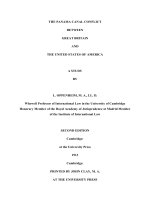Considering the Creation of a Domestic Intelligence Agency in the United States pot
Bạn đang xem bản rút gọn của tài liệu. Xem và tải ngay bản đầy đủ của tài liệu tại đây (973.87 KB, 218 trang )
This document and trademark(s) contained herein are protected by law as indicated
in a notice appearing later in this work. This electronic representation of RAND
intellectual property is provided for non-commercial use only. Unauthorized
posting of RAND PDFs to a non-RAND Web site is prohibited. RAND PDFs are
protected under copyright law. Permission is required from RAND to reproduce,
or reuse in another form, any of our research documents for commercial use. For
information on reprint and linking permissions, please see RAND Permissions.
Limited Electronic Distribution Rights
Visit RAND at www.rand.org
Explore the RAND Homeland Security Program
RAND Intelligence Policy Center
View document details
For More Information
This PDF document was made available
from www.rand.org as a public service of
the RAND Corporation.
6
Jump down to document
THE ARTS
CHILD POLICY
CIVIL JUSTICE
EDUCATION
ENERGY AND ENVIRONMENT
HEALTH AND HEALTH CARE
INTERNATIONAL AFFAIRS
NATIONAL SECURITY
POPULATION AND AGING
PUBLIC SAFETY
SCIENCE AND TECHNOLOGY
SUBSTANCE ABUSE
TERRORISM AND
HOMELAND SECURITY
TRANSPORTATION AND
INFRASTRUCTURE
WORKFORCE AND WORKPLACE
The RAND Corporation is a nonprofit
research organization providing
objective analysis and effective
solutions that address the challenges
facing the public and private sectors
around the world.
Purchase this document
Browse Books & Publications
Make a charitable contribution
Support RAND
HOMELAND SECURITY PROGRAM and
the INTELLIGENCE POLICY CENTER
This product is part of the RAND Corporation monograph series.
RAND monographs present major research findings that address the
challenges facing the public and private sectors. All RAND mono-
graphs undergo rigorous peer review to ensure high standards for
research quality and objectivity.
Contributors: Peter Chalk, Richard Warnes, Lindsay Clutterbuck, Aidan Kirby
HOMELAND SECURITY PROGRAM and
the INTELLIGENCE POLICY CENTER
Prepared for the Department of Homeland Security
Lessons from the Experiences of Australia, Canada,
France, Germany, and the United Kingdom
Considering the
Creation of a Domestic
Intelligence Agency in
the United States
BRIAN A. JACKSON, EDITOR
The RAND Corporation is a nonprofit research organization providing
objective analysis and effective solutions that address the challenges
facing the public and private sectors around the world. RAND’s
publications do not necessarily reflect the opinions of its research clients
and sponsors.
R
®
is a registered trademark.
© Copyright 2009 RAND Corporation
All rights reserved. No part of this book may be reproduced in any
form by any electronic or mechanical means (including photocopying,
recording, or information storage and retrieval) without permission in
writing from RAND.
Published 2009 by the RAND Corporation
1776 Main Street, P.O. Box 2138, Santa Monica, CA 90407-2138
1200 South Hayes Street, Arlington, VA 22202-5050
4570 Fifth Avenue, Suite 600, Pittsburgh, PA 15213-2665
RAND URL:
To order RAND documents or to obtain additional information, contact
Distribution Services: Telephone: (310) 451-7002;
Fax: (310) 451-6915; Email:
Library of Congress Cataloging-in-Publication Data
Considering the creation of a domestic intelligence agency in the United States : lessons
from the experiences of Australia, Canada, France, Germany, and the United
Kingdom / Brian A. Jackson, editor.
p. cm.
Includes bibliographical references.
ISBN 978-0-8330-4617-8 (pbk. : alk. paper)
1. Intelligence service—United States. 2. Intelligence service—Western countries.
3. Terrorism—United States—Prevention. 4. Terrorism—Government policy—
United States. I. Jackson, Brian A.
JK468.I6C66 2009
363.28—dc22
2008046790
Cover photo courtesy of AP Photo/Mary Altaffer.
This research was sponsored by the United States Department of
Homeland Security and was conducted jointly under the auspices of the
Homeland Security Program within RAND Infrastructure, Safety, and
Environment and the Intelligence Policy Center of the National Security
Research Division.
iii
Preface
With terrorism still prominent on the U.S. national agenda, whether
the country’s prevention efforts match the threat it faces continues to
be central in policy debate. One element of this debate is questioning
whether the United States, like some other countries, needs a dedi-
cated domestic intelligence agency. To examine this question, Con-
gress directed that the U.S. Department of Homeland Security Office
of Intelligence and Analysis perform “an independent study on the fea-
sibility of creating a counter terrorism intelligence agency” (U.S. Con-
gress, 2006, p. 122). e results of this study are presented in three
volumes:
is volume contains case studies of other nations’ domestic intel-t
ligence organizations and activities.
An additional volume, published separately, t e Challenge of
Domestic Intelligence in a Free Society: A Multidisciplinary Look
at the Creation of a U.S. Domestic Counterterrorism Intelligence
Agency (Jackson, 2009), presents a series of papers examining
the U.S. context for domestic intelligence, current activities, and
varied approaches for assessing options.
e overarching policy results of the assessment, including a t
discussion of the pros and cons of creating a new intelligence
organization, are included in a companion volume to this work:
Reorganizing U.S. Domestic Intelligence: Assessing the Options
(Tr everton, 2008).
iv Considering the Creation of a Domestic Intelligence Agency in the United States
is volume should be of interest to homeland security
policymakers, state and local governments, law enforcement orga-
nizations, civil rights and civil liberties organizations, and private-
sector organizations with interests in homeland security. is study is
part of a larger body of RAND research related to homeland security,
intelligence, and terrorism. Related RAND publications include the
following:
Peter Chalk and William Rosenau, t Confronting the “Enemy
Within”: Security Intelligence, the Police, and Counterterrorism in
Four Democracies, MG-100-RC, 2004
K. Jack Riley, Gregory F. Treverton, Jeremy M. Wilson, and Lois t
M. Davis, State and Local Intelligence in the War on Terrorism,
MG-394-RC, 2005
Brian A. Jackson, Peter Chalk, Kim Cragin, Bruce Newsome, t
John V. Parachini, William Rosenau, Erin M. Simpson, Melanie
Sisson, and Donald Temple, Breaching the Fortress Wall: Under-
standing Terrorist Efforts to Overcome Defensive Technologies, MG-
481-DHS, 2007.
The RAND Homeland Security Program
is research was conducted jointly under the auspices of the Home-
land Security Program within RAND Infrastructure, Safety, and Envi-
ronment and the Intelligence Policy Center of the National Security
Research Division. e mission of RAND Infrastructure, Safety, and
Environment is to improve the development, operation, use, and pro-
tection of society’s essential physical assets and natural resources and
to enhance the related social assets of safety and security of individuals
in transit and in their workplaces and communities. Homeland Secu-
rity Program research supports the Department of Homeland Security
and other agencies charged with preventing and mitigating the effects
of terrorist activity within U.S. borders. Projects address critical infra-
structure protection, emergency management, terrorism risk man-
Preface v
agement, border control, first responders and preparedness, domestic
threat assessments, domestic intelligence, and workforce and training.
Information about the Homeland Security Program is available
online ( Inquiries about homeland
security research projects should be addressed to
Andrew Morral, Director
Homeland Security Program, ISE
RAND Corporation
1200 South Hayes Street
Arlington, VA 22202-5050
703-413-1100, x5119
The RAND Intelligence Policy Center
e Intelligence Policy Center is part of the RAND National Secu-
rity Research Division (NSRD). NSRD conducts research and analysis
for the Office of the Secretary of Defense, the Joint Staff, the Unified
Combatant Commands, the defense agencies, the Department of the
Navy, the Marine Corps, the U.S. Coast Guard, the U.S. Intelligence
Community, allied foreign governments, and foundations.
For more information on RAND’s Intelligence Policy Center,
address queries to
John Parachini, Director
Intelligence Policy Center
RAND Corporation
1200 South Hayes Street
Arlington, VA 22202-5050
703-413-1100, x5579
More information about RAND is available at www.rand.org
vii
Contents
Preface iii
Figure and Tables
xi
Acknowledgments
xiii
Abbreviations
xv
CHAPTER ONE
Introduction 1
Defining Domestic Intelligence
3
Arguments for Change in Current Domestic Intelligence Policies
6
About is Study
8
Examining Other Nations’ Experiences with Domestic Intelligence
9
About is Volume and Companion Volumes from the Study
11
CHAPTER TWO
Australia 13
Peter Chalk
Creation and Relevant History
14
Mission and Critical Capabilities
16
Leadership and Human Capital
23
Management and Process
24
Organizational Structure and Funding Patterns
27
Key Relationships with Other Intelligence and Law Enforcement
Agencies
27
e Australian Intelligence Community
27
Law Enforcement
31
Oversight
33
viii Considering the Creation of a Domestic Intelligence Agency in the United States
Performance Metrics 35
Problems or Controversies
38
Conclusion
41
CHAPTER THREE
Canada 43
Peter Chalk
Creation and Relevant History
44
Mission and Critical Capabilities
45
Leadership and Human Capital
51
Management and Process
52
Organizational Structure and Funding Patterns
53
Key Relationships with Other Intelligence and Law Enforcement
Agencies
54
e Canadian Intelligence Community
54
Law Enforcement
55
Oversight
57
Performance Metrics
60
Problems or Controversies
61
Conclusion
64
CHAPTER FOUR
France 65
Richard Warnes
Creation and Relevant History
65
Mission and Critical Capabilities
73
Leadership and Human Capital
77
Management and Process
78
Organizational Structure and Funding Patterns
82
Key Relationships with Other Intelligence and Law Enforcement
Agencies
82
Oversight
85
Problems or Controversies
87
Conclusion
90
Contents ix
CHAPTER FIVE
Germany 93
Richard Warnes
Creation and Relevant History
93
Mission and Critical Capabilities
98
Leadership and Human Capital
103
Management and Process
104
Organizational Structure and Funding Patterns
104
Key Relationships with Other Intelligence and Law Enforcement
Agencies
107
Oversight
110
Problems or Controversies
111
Conclusion
114
CHAPTER SIX
e United Kingdom 115
Lindsay Clutterbuck
Creation and Relevant History
116
Mission and Critical Capabilities
121
Leadership and Human Capital
124
Management and Process
126
Organizational Structure and Funding Patterns
127
Key Relationships with Other Intelligence and Law Enforcement
Agencies
129
Oversight
132
Ministerial Oversight
134
Parliamentary Oversight
134
Functional Oversight
135
Performance Metrics
136
Problems or Controversies
138
Conclusion
140
CHAPTER SEVEN
Domestic Intelligence Agencies After September 11, 2001:
How Five Nations Have Grappled with the Evolving reat
143
Aidan Kirby
x Considering the Creation of a Domestic Intelligence Agency in the United States
Australia 144
Canada
147
France
149
Germany
152
United Kingdom
154
Conclusion
157
CHAPTER EIGHT
Conclusions: Lessons for the United States 161
Peter Chalk, Lindsay Clutterbuck, Brian A. Jackson, and
Richard Warnes
Separation of Domestic Intelligence from Law Enforcement
Authority
162
External Oversight
165
Community Interaction and Liaison
166
Cross-Agency International and Regional Structures
167
A Blurred Boundary Between Domestic and Foreign
168
References
171
xi
Figure and Tables
Figure
2.1. ASIO’s Corporate Governance Structure 25
Tables
2.1. ASIO Organizational Structure, 2007 28
2.2. ASIO Client Survey Results, 2003–2005
37
3.1. Median Turnaround Time in Days of CSIS
Government Security Screening, 2003–2006
49
3.2. Immigration Screening Requests, 2005–2006
49
6.1. Powers and Numbers of Authorized Agencies
Under RIPA, Including the Security Service
124
6.2. Levels of Accountability for the Security Service
134
xiii
Acknowledgments
Like many RAND projects, this study relied on the efforts and contri-
butions of a number of individuals inside RAND beyond those who
are listed as authors of the chapters, as well as a variety of people out-
side of RAND who made critical contributions to the study.
First, we would like to acknowledge the contribution of our col-
league and co–project leader for the study, Gregory Treverton. Greg’s
involvement significantly shaped the conduct of the project, and his
experience and views were instrumental in shaping elements of the
analyses included in this volume. In addition to the individual authors
listed on the chapters, other RAND staff made important contribu-
tions to the conduct of the project, including, in alphabetical order,
Mike Hix, Gordon T. Lee, Andrew R. Morral, John Parachini,
K. Jack Riley, Lynn M. Scott, Douglas Shontz, Jerry M. Sollinger, and
Katharine Watkins Webb. As part of the review of the various project
documents and reports by experts both inside and outside RAND,
Daniel Byman, James B. Bruce, Charles Nemfakos, Paul C. Light, and
Paul R. Pillar all made important contributions to our thinking.
During our research, we reached out to experts and practitio-
ners in the relevant fields and spoke to a wide range of individuals,
only some of whom we can identify by name. A number of individuals
inside and outside government at the federal, state, and local levels gave
generously of their time and expertise in interviews with various proj-
ect team members. However, because interviews were conducted on
a not-for-attribution basis, we do not name those contributors in this
monograph. e project also benefited from the involvement of a panel
xiv Considering the Creation of a Domestic Intelligence Agency in the United States
of eminent experts in intelligence, law enforcement, and related areas
who provided input at a key point in the study. e members of that
expert panel, also listed alphabetically, were Marion Bowman, John
Brennan, Joan Dempsey, Michael German, Richard Jerome, Richard
Posner, Suzanne Spaulding, John P. Sullivan, and John Yoo.
We would also like to acknowledge the contribution of Erin-
Elizabeth Johnson of RAND Publications and Creative Services, whose
careful and comprehensive edit of the document greatly improved the
final product.
xv
Abbreviations
AAT Administrative Appeals Tribunal
AD Action Directe [Direct Action]
AFP Australian Federal Police
AG Attorney-General
AIC Australian intelligence community
ANAO Australian National Audit Office
AQMI Al-Qaida pour le Maghreb Islamique [al Qaeda for
the Islamic Maghreb]
ASALA Armenian Secret Army for the Liberation of
Armenia
ASIO Australian Security Intelligence Organisation
ASIS Australian Secret Intelligence Service
AUSTRAC Australian Transaction Reports and Analysis Centre
BCRA Bureau Central de Renseignements et d’Action
[Central Office of Intelligence and Operations]
BfV Bundesamtes für Verfassungsschutz [Federal Office
for the Protection of the Constitution]
BGS Bundesgrenzschutz [federal border guards]
xvi Considering the Creation of a Domestic Intelligence Agency in the United States
BKA Bundeskriminalamt [federal criminal police]
BLU Business Liaison Unit
BMI Bundesministerium des Innern [Federal Ministry of
the Interior of the Federal Republic of Germany]
BND Bundesnachrichtendienst [Federal Intelligence
Service]
BSI Bundesamtes für Sicherheit in der
Informationstechnik [Federal Office for the Security
of Information Technology]
BVerfSchG Bundesverfassungsschutzgesetz [Federal Law for the
Protection of the Constitution]
C-36 the Anti-Terrorism Act of Canada
CBRNE chemical, biological, radiological, nuclear, or
explosive
CBSA Canada Border Services Agency
CHIS covert HUMINT source
CI critical infrastructure
CIA Central Intelligence Agency
CIC Canadian intelligence community
CID Criminal Investigation Department
CILAT Comité Interministériel de Lutte Anti-terroriste
[Interministerial Committee for the Anti-Terrorist
Struggle]
CNI Critical National Infrastructure
CPNI Centre for the Protection of National Infrastructure
CSIS Canadian Security Intelligence Service
Abbreviations xvii
CT counterterrorism
CTIU Counter Terrorism Intelligence Unit
CTU Counter Terrorism Unit
DCRG Direction Centrale des Renseignements Généraux
[Central Directorate of General Intelligence]
DCRI Direction Centrale du Renseignement Intérieur
[Central Directorate of Interior Intelligence]
DG Director-General
DGSE Direction Générale de la Sécurité Extérieure
[General Directorate for External Security]
DIGO Defense Imagery and Geospatial Organisation
DNAT Division Nationale Anti-terroriste [National Anti-
Terrorist Division]
DND Department of National Defence
DRM Direction du Renseignement Militaire [Military
Intelligence Directorate]
DSD Defense Signals Directorate
DST Direction de la Surveillance du Territoire
[Directorate of Territorial Surveillance]
FBI Federal Bureau of Investigation
FLN Front de Libération Nationale [National Liberation
Front]
FRG Federal Republic of Germany
GCHQ Government Communications Headquarters
GDR German Democratic Republic
GIA Groupe Islamique Armé [Armed Islamic Group]
xviii Considering the Creation of a Domestic Intelligence Agency in the United States
GIGN Groupe d’Intervention de la Gendarmerie Nationale
[Intervention Group of the National Gendarmerie]
GSG 9 Grenzschutzgruppe 9 [Border Guard Group 9]
GSPC Groupe Salafiste pour la Prédication et le Combat
[Salafist Group for Prayer and Combat]
GTAZ Gemeinsamen Terrorismusabwehrzentrum [Joint
Counterterrorism Center]
HMRC Her Majesty’s Revenue and Customs
HUMINT human intelligence
HVA Hauptverwaltung Aufklärung [East German
administration]
IGIS Inspector-General of Intelligence and Security
IGPN inspection Générale de la Police Nationale [General
Inspectorate of the National Police]
IJU Islamic Jihad Union
INTERPOL International Criminal Police Organization
IPT Investigatory Powers Tribunal
IRA Irish Republican Army
ISC Intelligence and Security Committee
ITAC Integrated reat Assessment Centre
JCTICU Joint Counter-Terrorism Intelligence Coordination
Unit
JI Jemaah Islamiya
JTAC Joint Terrorism Analysis Centre
KGB Komityet Gosudarstvennoy Bezopasnosty
[Committee for State Security]
Abbreviations xix
LfV Landesamt für Verfassungsschutz [regional
intelligence organization]
LKA Landeskriminalamt [regional or state criminal
police]
LTTE Liberation Tigers of Tamil Eelam
MAD Militärische Abschirmdienst [Military Intelligence
Service]
MfS Ministerium für Staatssicherheit [Ministry for State
Security]
MI5 U.K. Security Service
NADIS Nachrichtendienstliche Informationssystem
[Intelligence Service Information System]
NAO National Audit Office
NCTC National Counter-Terrorism Committee
NPD Nationaldemokratische Partei Deutschlands
[German National Democratic Party]
NSA National Security Agency
NTAC National reat Assessment Centre
OAS Organisation de l’Armée Secrète [Organization of
the Secret Army]
ONA Office of National Assessments
OSCT Office for Security and Counter-Terrorism
PCF Parti Communiste Français [French Communist
Party]
PDS Partei des Demokratischen Sozialismus [Democratic
Socialist Party]
xx Considering the Creation of a Domestic Intelligence Agency in the United States
PJCIS Parliamentary Joint Committee on Intelligence and
Security
PKGr Parlamentarische Kontrollgremium [Parliamentary
Standing Committee for the Intelligence Services]
PKK Partiya Karkerên Kurdistan [Kurdish Workers’
Party]
PM&C Department of the Prime Minister and Cabinet
PMV politically motivated violence
PSEP Minister of Public Safety and Emergency
Preparedness
RAF Rote Armee Fraktion [Red Army Faction]
RCMP Royal Canadian Mounted Police
RER Réseau Express Régional [Regional Express
Network]
RIPA Regulation of Investigatory Powers Act 2000
SA Service Action [Action Service]
SCoNS Secretaries Committee on National Security
SDAT Sous-Direction Anti-terroriste [Anti-Terrorist Sub-
Directorate]
SGDN Secrétariat Général de la Défense Nationale [General
Secretariat of National Defense]
SIGINT signals intelligence
SIM subscriber identity module
SIRC Security Intelligence Review Committee
SIS Secret Intelligence Service
SOCA Serious Organised Crime Agency
Abbreviations xxi
SWAG Special Weapons Analysis Group
TA threat assessment
TARC Target and Approval and Review Committee
TEL terrorist-entity listing
TRA threat and risk assessment
UCLAT Unite de Coordination de la Lutte Anti-terroriste
[Coordination Unit for the Anti-Terrorist Struggle]
1
CHAPTER ONE
Introduction
In the current environment, the threat of terrorism is a major shap-
ing force of many nations’ international and domestic security poli-
cies. Nonstate groups with the intent and capability to take violent
action are a reality in many countries given the existence of interna-
tional movements, such as al Qaeda, that have the capacity to direct
or inspire violence across the world, thereby creating another source
of threat and risk. e threat of terrorist activity extends across a wide
spectrum, from attacks causing little in the way of injury or damage to
the potential for large-scale incidents. Although the probability of such
high-consequence scenarios occurring is comparatively low, their abil-
ity to cause national-scale outcomes has meant that governments have
focused their efforts on seeking to prevent them.
e core of government attempts to prevent violent and other
criminal activity is intelligence and law enforcement, which, for many
years, were viewed by Americans as separate activities. Put in place
mainly to address the threat posed by agencies and agents of foreign
governments, intelligence was viewed as an internationally focused
activity that occurred largely outside U.S. borders. Intelligence agencies
were charged with gathering information and learning about threats
to the country, not prosecuting the perpetrators; these activities were
designed to make it possible to take action to prevent attacks from hap-
pening. Law enforcement, in contrast, was done “at home” and, while
certainly designed to help deter or prevent criminal activity, was largely
a reactive enterprise. Law enforcement organizations, which generally
did not act until after something had already happened, aimed to make









